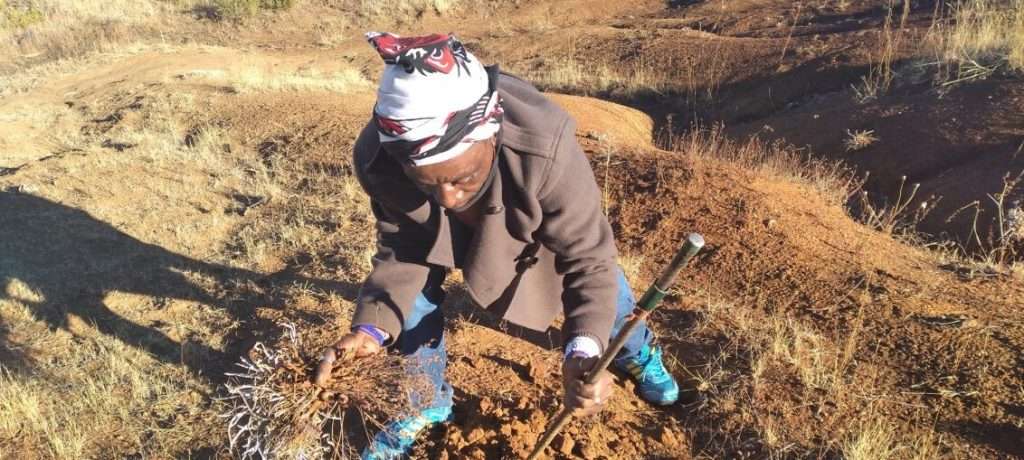Life-Saving Medicinal Plants Face Extinction
30 July 2021 by Pascalinah Kabi

Lesotho traditional healer Mohaneng Lekhooana harvests medicinal plants in his home town. Credit: Pascalinah Kabi
Shivering and moaning, 36-year-old ’Mantoa Kobeli can barely sit unassisted on a plastic chair in a “consulting room”, a shack run by a traditional healer, Monaheng Lekhooana.
A burning blue candle and a small bowl oozing an aromatic smell from burning medicinal plants sit between Mr Lekhooana and Ms Kobeli.
Ms Kobeli first visited Mr Lekhooana towards the end of May this year but was too sick to take up an interview, Mr Lekhooana said.
“When she first came here, she could not even disembark from the car but she would be up on her feet by end of this week if I had found Phela today (3 June 2021),” Mr Lekhooana said.
Ironically, Phela is a Sesotho word that means life.
The medicinal plant, whose botanical name is Othonna natalensis, is one of at least 12 medicinal plants facing extinction in Lesotho, threatening to further widen health and income gaps for indigenous communities in the country.
Others are Othonna natalensis (Elephant’s root), Hypoxis hemerocallidea (African potato or star flower), Dicoma anomala (stomach bush), Pentanisia prunelloides (broad-leaved pentanisia), Bulbine narcissifolia (star-leaved bulbine), Eriocephalus tenuifolius (wild rosemary), Alepidea amatymbica (giant alepidea), Alepidea amatymbica (star-leaved bulbine), Alepidea amatymbica (milkwort), Aloe polyphylla and African Geranium.
Mr Lekhooana and other traditional herbalists use African potato for chronic wounds and for boosting the immune system; star-leaved bulbine for cleansing kidney and blood vessels, digestive problems, bloating, heartburn, dilates blood vessels, promotes diuresis and burning urine and stomach bush for general body pains, diarrhoea, colic, rheumatism and fevers.
Star-leaved bulbine is used to treat general body pains, diarrhoea, colic, rheumatism and fevers; broad-leaved pentanisia is famous for burns, wounds, sores, snakebites and boils while another plant also known as broad-leaved pentanisia or poho-tśehla in Sesotho heals headache and relieves stress.

Medicinal plants facing extinction in Lesotho
These plants, a crucial part in the lives of local communities, are facing extinction due to climate change and uncontrolled overharvesting.
National University of Lesotho senior lecturer, Dr Lerato Seleteng-Kose, says many communities without access to health facilities depend on medicinal plants as a source of income and for treating common ailments.
“The disappearance of these plants negatively affects their health and livelihoods,” Dr Seleteng-Kose said.
A trail of destruction
A 3-am alarm sets off in time for Mr Lekhooana to prepare for a day-long scramble for medicinal plants at his home town – Ha Mantša.
Ha Mantša rests on the foothills of one of the beautiful mountains in Lesotho – Thabana-Li-’Mele – with a 2 533-metre elevation in the capital Maseru.
The more 20 kilometres journey from the main road leads to a dry mountainous area. Top of Mr Lekhooana’s medicinal plants’ hunting list is Othonna natalensis, locally known as Phela – a Sesotho word that means life.
“I have a very sick patient and I am 100 percent sure that Phela will heal her,” a visibly stressed 43-year-old healer said.
Growing up in Ha Mantša, Mr Lekhooana and his brothers traversed Ha Mantsa, a scenic mountainous village, to harvest medicinal plants for his late grandmother, ’Maliabo Lekhooana.
“We are now struggling to get these medicines,” Mr Lekhooana said, suspecting drought spells the country experienced from 2015 could be responsible for this.

Monaheng Lekhooana, an informal trader who specialises in traditional medicine practice, sits in his consulting shack in Maseru. Credit: Pascalinah Kabi
He argues that burning different materials has a dire effect on the rainfall as burning fossil fuels such as natural gas, coal, oil and gasoline raise the level of carbon dioxide in the atmosphere, thus negatively impacting the availability of life-saving medicinal plants in the country.
Carbon dioxide is a major contributor to greenhouse gases and global warming.
Aloe polyphylla, according to Dr Seleteng-Kose, is endemic to Lesotho and under threat due to “illegal trade” while the African Geranium population is declining due to its “heavy harvesting for export”.
The looming extinction is worrying because “the world is shifting towards the use of traditional medicine, in which medicinal plants play a big role”.
She says reports indicate that about 25 percent of modern medicines are made from plants that were first used as traditional medicines.
Her career path was inspired by seeing people selling medicinal plants and their products in the capital Maseru and wanted to find out if “these medicinal plants really work or it is merely a way of income generation for traders”.
In her 2016 study published by the University of Johannesburg, Medicinal plants used in Lesotho for treatment of reproductive and post-reproductive problems, she says 87 plant species are reportedly used for the treatment of several reproductive problems in the country.
She has come across a very disturbing discovery in her scientific investigations. “I have come across a lot of medicinal plants that are currently scarce. I struggled to get some of them during my PhD research in which I was investigating some of these medicinal plants.”
The scarcity is due to uncontrolled, overharvesting and effects of climate change.
“Climate change is one of the driving forces that cause the decline of medicinal plants. The recent drought and delayed rains have negatively affected the habitats of these medicinal plants and, in turn, their populations.”
A non-governmental organisation established to identify appropriate technologies that can relieve the environment from high exploitation of its resources, Technologies for Economic Development (TED), argues medicinal plants are facing extinction because of the country’s failure to protect rangelands.
“Lesotho has plenty of medicinal plants which we know from childhood. Unfortunately, they are facing extinction because we failed to protect our rangelands or we have just been overharvesting the medicinal plants without planting back,” TED Director ’Mantopi Lebofa said.
She says the disappearance of these plants could lead to non-resilience to diseases for people who have been relying on medicinal plants for health, leading further to reliance on external medication which leads to economic loss for these communities.
The Minister of Forestry, Range and Soil Conversation, Motlohi Maliehe, says legislation governing the use of rangelands and protection of natural resources like medicinal plants is outdated since it was passed in parliament in 1967.
“I am currently spearheading the drafting of the Range Management Resource Bill which I think will be tabled in parliament in September this year,” Mr Maliehe said.
He says the bill seeks to protect the country’s biodiversity, including medicinal plants which he says are being overharvested and exported to countries such as Germany and South African.
Traditional healers turn to SA for medicinal plants
Mr Lekhooana and other traditional healers have turned to Lesotho’s bigger and much wealthier neighbour, South Africa, for medicinal plants facing extinction in the country.
“Medicinal plants like Phela and Hloenya have diminished in Lesotho; we buy them from South Africa.”
Fortunately for him, one of his colleagues travelled to South Africa on June 10, 2021. He gave him money to buy scarce plants from Gauteng, South Africa, in time for him to administer the medication for Ms Kobeli.
“In a year, I spent roughly M10 000 to buy medicinal plants from South Africa,” he said.
The money could sustain his family for roughly four months. His colleague came back two days later.
“I went to her (Kobeli) house and administered the medication. I am happy with the progress,” Mr Lekhooana said.
Lesotho’s Department of Meteorology acting director Mokoena France proposes that the country can construct greenhouses to plant and preserve these plants as part of a mitigation strategy.
“We can construct greenhouses that can mimic climate conditions favourable for these plants, grow them in this structure because we cannot stop the climate from changing as long as excess greenhouse gases have not been removed from the atmosphere,” Mr Mokoena said.
Govt told to criminalise uncontrolled harvesting, build national botanical garden
On July 19, 2014, the UN General Assembly’s Open Working Group on Sustainable Development Goals forwarded a proposal for the SDGs to the Assembly, containing 17 goals with 169 targets covering a broad range of sustainable development issues which included combating climate change.
Mr Lekhooana proposes that Lesotho can mitigate effects of climate change on medicinal plants by building a national botanical garden.
“My desire is to see our country identifying a large plot to plant these medicinal plants. Only licensed traditional healers must be allowed to harvest from there,” Mr Lekhooana said, adding “even foreigners would visit our country to learn from Lesotho”.
Dr Seleteng-Kose says the conservation of these plants should be a priority, otherwise they may face extinction.
“Proposed measures include establishment of more botanical gardens, the country has only two botanical gardens – NUL and Katse – with no national botanical garden and establishment of more protected areas where some of these plants are occurring in significant numbers,” Dr Seleteng-Kose said.
She indicates that Lesotho has only one percent of the targeted 17 percent of its land area under protection, proposing that Lesotho must consider inclusion of biodiversity conservation in school curricula as well as implementing legislation that protects threatened plants from harvesting.
She adds that Lesotho must follow in South Africa’s footsteps and criminalise uncontrolled harvesting of medicinal plants.
“In South Africa, it is a criminal offence to collect plants without a collecting permit, which is also not easy to get. However, in Lesotho anybody can just collect plants as they please without any permit. Even plants that are threatened and protected by law from harvesting are still being collected,” Dr Seleteng-Kose said.
However, Dr Seleteng-Kose warns that the main challenges to proposed solutions include fragmented and outdated legislation and its implementation in the country, as well as stakeholders who are working in silos.
On her part, Ms Lebofa says, “these medicinal plants need to be propagated and planted massively”.
Indigenous communities key to proposed solutions
In many African states, intervention programmes are imposed on indigenous people but Mr Maliehe says this is not the case with the proposed Range Management Resource Bill.
Leaving indigenous communities behind would be suicidal since they are the custodians of our biodiversity, he argues.
“We started by sensitising indigenous communities on the importance of protecting, preserving and rehabilitating rangelands. This enabled them to come up with home-bred solutions to the biodiversity challenges we are facing”.
This is in line with the United Nations Guiding Principles on Business & Human Rights and Indigenous People’s June report which says governments should review their legislation to ensure compliance with indigenous peoples’ rights as set out.
“This in particular to ensure that business activity is carried out in such a manner that their right to self-determination is protected and respected, including their rights over lands, territories and resources traditionally occupied,” read the report.
Ms Lebofa says, “indigenous communities are the most important as their daily lives depend directly on biodiversity that includes the medicinal plants”.
She says educating them on biodiversity would enable communities to meaningfully contribute to the attainment of SDGs by “caring for resources of this country”.
“We also have to recognise the indigenous communities’ contribution in caring for resources of our country”.
On her part, Dr Seleteng-Kose argues that all stakeholders – government, scientists, traditional healers and indigenous communities – have a role to play and must work together to preserve these plants.
“It is also equally important to liaise with indigenous communities, that is traditional practitioners and herbalists who are the bearers of this important information on the historical use of medicinal plants”.
This report was produced by MNN Centre for Investigative Journalism with Indigenous Environmental Journalism Story Grant from Internews’ Earth Journalism Network.


